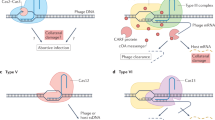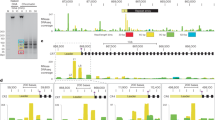Abstract
Bacteria and archaea generate adaptive immunity against phages and plasmids by integrating foreign DNA of specific 30–40-base-pair lengths into clustered regularly interspaced short palindromic repeat (CRISPR) loci as spacer segments1,2,3,4,5,6. The universally conserved Cas1–Cas2 integrase complex catalyses spacer acquisition using a direct nucleophilic integration mechanism similar to retroviral integrases and transposases7,8,9,10,11,12,13. How the Cas1–Cas2 complex selects foreign DNA substrates for integration remains unknown. Here we present X-ray crystal structures of the Escherichia coli Cas1–Cas2 complex bound to cognate 33-nucleotide protospacer DNA substrates. The protein complex creates a curved binding surface spanning the length of the DNA and splays the ends of the protospacer to allow each terminal nucleophilic 3′-OH to enter a channel leading into the Cas1 active sites. Phosphodiester backbone interactions between the protospacer and the proteins explain the sequence-nonspecific substrate selection observed in vivo2,3,4. Our results uncover the structural basis for foreign DNA capture and the mechanism by which Cas1–Cas2 functions as a molecular ruler to dictate the sequence architecture of CRISPR loci.
This is a preview of subscription content, access via your institution
Access options
Subscribe to this journal
Receive 51 print issues and online access
$199.00 per year
only $3.90 per issue
Buy this article
- Purchase on Springer Link
- Instant access to full article PDF
Prices may be subject to local taxes which are calculated during checkout




Similar content being viewed by others
References
Barrangou, R. et al. CRISPR provides acquired resistance against viruses in prokaryotes. Science 315, 1709–1712 (2007)
Mojica, F. J., Diez-Villasenor, C., Garcia-Martinez, J. & Soria, E. Intervening sequences of regularly spaced prokaryotic repeats derive from foreign genetic elements. J. Mol. Evol. 60, 174–182 (2005)
Bolotin, A., Quinquis, B., Sorokin, A. & Ehrlich, S. D. Clustered regularly interspaced short palindrome repeats (CRISPRs) have spacers of extrachromosomal origin. Microbiology 151, 2551–2561 (2005)
Pourcel, C., Salvignol, G. & Vergnaud, G. CRISPR elements in Yersinia pestis acquire new repeats by preferential uptake of bacteriophage DNA, and provide additional tools for evolutionary studies. Microbiology 151, 653–663 (2005)
Garneau, J. E. et al. The CRISPR/Cas bacterial immune system cleaves bacteriophage and plasmid DNA. Nature 468, 67–71 (2010)
van der Oost, J., Westra, E. R., Jackson, R. N. & Wiedenheft, B. Unravelling the structural and mechanistic basis of CRISPR–Cas systems. Nature Rev. Microbiol. 12, 479–492 (2014)
Yosef, I., Goren, M. G. & Qimron, U. Proteins and DNA elements essential for the CRISPR adaptation process in Escherichia coli . Nucleic Acids Res. 40, 5569–5576 (2012)
Datsenko, K. A. et al. Molecular memory of prior infections activates the CRISPR/Cas adaptive bacterial immunity system. Nature Comm. 3, 945 (2012)
Swarts, D. C., Mosterd, C., van Passel, M. W. & Brouns, S. J. CRISPR interference directs strand specific spacer acquisition. PLoS ONE 7, e35888 (2012)
Nuñez, J. K. et al. Cas1-Cas2 complex formation mediates spacer acquisition during CRISPR–Cas adaptive immunity. Nature Struct. Mol. Biol. 21, 528–534 (2014)
Arslan, Z., Hermanns, V., Wurm, R., Wagner, R. & Pul, U. Detection and characterization of spacer integration intermediates in type I-E CRISPR–Cas system. Nucleic Acids Res. 42, 7884–7893 (2014)
Nuñez, J. K., Lee, A. S., Engelman, A. & Doudna, J. A. Integrase-mediated spacer acquisition during CRISPR–Cas adaptive immunity. Nature 519, 193–198 (2015)
Rollie, C., Schneider, S., Brinkmann, A. S., Bolt, E. L. & White, M. F. Intrinsic sequence specificity of the Cas1 integrase directs new spacer acquisition. eLife 4, 10.7554/eLife.08716 (2015)
Heler, R., Marraffini, L. A. & Bikard, D. Adapting to new threats: the generation of memory by CRISPR–Cas immune systems. Mol. Microbiol. 93, 1–9 (2014)
Brouns, S. J. et al. Small CRISPR RNAs guide antiviral defense in prokaryotes. Science 321, 960–964 (2008)
Carte, J., Wang, R., Li, H., Terns, R. M. & Terns, M. P. Cas6 is an endoribonuclease that generates guide RNAs for invader defense in prokaryotes. Genes Dev. 22, 3489–3496 (2008)
Haurwitz, R. E., Jinek, M., Wiedenheft, B., Zhou, K. & Doudna, J. A. Sequence- and structure-specific RNA processing by a CRISPR endonuclease. Science 329, 1355–1358 (2010)
Deltcheva, E. et al. CRISPR RNA maturation by trans-encoded small RNA and host factor RNase III. Nature 471, 602–607 (2011)
Jinek, M. et al. A programmable dual-RNA-guided DNA endonuclease in adaptive bacterial immunity. Science 337, 816–821 (2012)
Levy, A. et al. CRISPR adaptation biases explain preference for acquisition of foreign DNA. Nature 520, 505–510 (2015)
Wiedenheft, B. et al. Structural basis for DNase activity of a conserved protein implicted in CRISPR-mediated genome defense. Structure 17, 904–912 (2009)
Savilahti, H., Rice, P. A. & Mizuuchi, K. The phage Mu transpososome core: DNA requirements for assembly and function. EMBO J. 14, 4893–4903 (1995)
Scottoline, B. P., Chow, S., Ellison, V. & Brown, P. O. Disruption of the terminal base pairs of retroviral DNA during integration. Genes Dev. 11, 371–382 (1997)
Katz, R. A., Merkel, G., Andrake, M. D., Roder, H. & Skalka, A. M. Retroviral integrases promote fraying of viral DNA ends. J. Biol. Chem. 286, 25710–25718 (2011)
Adams, P. D. et al. PHENIX: a comprehensive Python-based system for macromolecular structure solution. Acta Crystallogr. D 66, 213–221 (2010)
Emsley, P. & Cowtan, K. Coot: model-building tools for molecular graphics. Acta Crystallogr. D 60, 2126–2132 (2004)
Babu, M. et al. A dual function of the CRISPR–Cas system in bacterial antivirus immunity and DNA repair. Mol. Microbiol. 79, 484–502 (2011)
Makarova, K. S. et al. Evolution and classification of the CRISPR–Cas systems. Nature Rev. Microbiol. 9, 467–477 (2011)
Katoh, K. & Standley, D. M. MAFFT multiple sequence alignment software version 7: improvements in performance and usability. Mol. Biol. Evol. 30, 772–780 (2013)
Acknowledgements
We thank G. Meigs and the 8.3.1 beamline staff at the Advanced Light Source for assistance with data collection, J. Chen for input on experimental design and members of the Doudna laboratory for comments and discussions. The 8.3.1 beamline is supported by UC Office of the President, Multicampus Research Programs and Initiatives grant MR-15-328599 and Program for Breakthrough Biomedical Research, which is partially funded by the Sandler Foundation. This project was funded by US National Science Foundation grant No. 1244557 to J.A.D. and by NIH grant AI070042 to A.N.E. J.K.N. and L.B.H. are supported by US National Science Foundation Graduate Research Fellowships and J.K.N. by a UC Berkeley Chancellor’s Graduate Fellowship. P.J.K. is supported as a Howard Hughes Medical Institute Fellow of the Life Sciences Research Foundation. J.A.D. is an Investigator of the Howard Hughes Medical Institute and a member of the Center for RNA Systems Biology.
Author information
Authors and Affiliations
Contributions
J.K.N. and L.B.H. conducted the crystallography, biochemistry and in vivo spacer acquisition assays. J.K.N., L.B.H. and P.J.K. collected the X-ray diffraction data and determined the crystal structures. J.K.N., L.B.H., P.J.K., A.N.E. and J.A.D. designed the study, analysed all data and wrote the manuscript.
Corresponding author
Ethics declarations
Competing interests
The authors declare no competing financial interests.
Extended data figures and tables
Extended Data Figure 2 Assembly of Cas1–Cas2 complex bound to protospacer DNA.
a, Gel filtration chromatogram of pre-assembled Cas1–Cas2 complex with protospacer DNA containing five-nucleotide 3′ overhangs. The dotted lines indicate the peak fractions of the Cas1–Cas2 complex without DNA, as shown in d. The dotted lines indicate the peak fractions of the Cas1–Cas2 complex bound to DNA (first peak) and excess, unbound DNA (second peak). b, c, The fractions from peak 1 (~12 ml) and peak 2 (~15 ml) were analysed by Coomassie-stained SDS–PAGE (b) and 12% urea-PAGE (c) to confirm the presence of Cas1, Cas2 and protospacer DNA. d, Gel-filtration chromatogram of assembled Cas1–Cas2 without protospacer DNA. e, Coomassie-stained SDS–PAGE of the peak fractions from d. Supplementary Information contains the full images for b, c and e.
Extended Data Figure 3 Conformational dynamics upon protospacer DNA binding.
a, An overlay of the DNA-bound Cas1–Cas2 structure with the apo Cas1–Cas2 (grey, PDB 4P6I). b, Vector lines depicting the conformational changes the Cas1–Cas2 complex undergoes upon protospacer DNA binding compared to the apo complex (PDB 4P6I). The Cas1 subunits rotate towards the direction of the arrows.
Extended Data Figure 4 Omit maps of the protospacer DNA.
a, Simulated annealing Fo − Fc omit electron density map of the entire protospacer DNA using the ‘no Mg2+’ map and model. b, c, Simulated annealing Fo − Fc omit electron density maps of the terminal five nucleotides in the active sites of the structures (a) with Mg2+ or (b) without Mg2+ in the crystallization condition. The maps are contoured at 2.0σ.
Extended Data Figure 5 Sequence alignment of Cas1 proteins in type I CRISPR systems.
Sequence alignments of Cas1 from representative organisms with type I CRISPR systems. The E. coli sequence is displayed at the top. The dots indicate the residues described in this study, with the red dots indicating the metal-binding residues. The box highlights the non-universal conservation of the E. coli Y22 residue in the β1 region of type I CRISPR systems. The secondary structure representations shown are for the E. coli Cas1.
Extended Data Figure 6 Integration of protospacer substrates with splayed ends.
a, Representative agarose gel of in vitro integration reactions using increasing lengths of splayed ends. The average per cent integration of three independent experiments is plotted in Fig. 3d. b, Sequences of protospacers used in the integration assays in a. c, A 12% denaturing polyacrylamide gel of protospacers after incubation with Cas1–Cas2 for 1 h at 37 °C in integration assay buffer conditions. The indicated DNA substrates are radiolabelled at the 5′ end. Supplementary Information contains the full images for a and c. nt, nucleotide.
Extended Data Figure 7 Crystallographic packing of the complex bound to Mg2+.
a, View of the symmetry mates (grey) contacting the non-catalytic Cas1 subunits (green). Catalytic Cas1 subunits are shown in blue, Cas2 in yellow and DNA is shown in salmon and red. b, Superposition of our two crystal structures, with or without Mg2+, shows a slight DNA kink in the structure bound to Mg2+ (dotted box). This region contacts α-helix 7 of a symmetry mate, as described in the text.
Supplementary information
Supplementary Information
This file contains uncropped gel images with size marker indications. (PDF 1129 kb)
Rights and permissions
About this article
Cite this article
Nuñez, J., Harrington, L., Kranzusch, P. et al. Foreign DNA capture during CRISPR–Cas adaptive immunity. Nature 527, 535–538 (2015). https://doi.org/10.1038/nature15760
Received:
Accepted:
Published:
Issue Date:
DOI: https://doi.org/10.1038/nature15760
This article is cited by
-
Structure reveals why genome folding is necessary for site-specific integration of foreign DNA into CRISPR arrays
Nature Structural & Molecular Biology (2023)
-
Structural and functional analyses of Burkholderia pseudomallei BPSL1038 reveal a Cas-2/VapD nuclease sub-family
Communications Biology (2023)
-
Mechanism for Cas4-assisted directional spacer acquisition in CRISPR–Cas
Nature (2021)
-
SCOPE enables type III CRISPR-Cas diagnostics using flexible targeting and stringent CARF ribonuclease activation
Nature Communications (2021)
-
Digging into the lesser-known aspects of CRISPR biology
International Microbiology (2021)
Comments
By submitting a comment you agree to abide by our Terms and Community Guidelines. If you find something abusive or that does not comply with our terms or guidelines please flag it as inappropriate.



